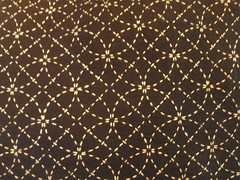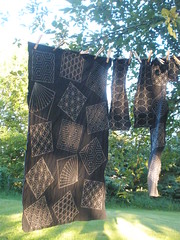"The stitch is worked by passing the needle in and out of the fabric. Running stitches may be of varying length, but typically more thread is visible on the top of the sewing than on the underside."
What could be a rather dull stitch can actually be presented in many different ways by simply varying the stitch length and using a variety of colors of embroidery floss.
Originally kogin was used as a form of darning or reinforcing work clothes. The patterns became more beautiful and were known for their intricate designs. Kogin is most commonly done with white thread on an indigo blue background.
From Min Gei Kan: Japanese Kogin
Meiji Period, 19th Century
"In order to keep warm (this area is buried in deep snow in winter), the women darned threads between the gaps of rough linen cloth to make it stronger and warmer. Later, the darning took on decorative patterns and the women would present their best Kogin works as festive wear. The Kogin patterns symbolized nature such as the dragonfly, nuts, butterflies, etc."
One of the samples I did this week. Under the purple embroidery floss are
green lines to mark where to stitch.
One of the sashiko patterns I embroidered in 2010.
This one was made into a pillow.
Traditional sashiko patterns are done with white thread on indigo ground fabric but modern sashiko is now done with multi-colored thread on various types of ground, including silk.
After I finished doing all the stitching on the sashiko fabric,
I washed each piece of fabric to remove the gold marks.
I dried it on the clothesline and then ironed the fabric.
What remains are the white stitches on indigo fabric.
Kogin embroidery is done on evenweave fabric and is stitched as an over/under darning pattern. In order to create the pattern, the horizontal stitches vary in length.
It doesn't show up well in the photo,
but there are two lighter shades of blue (Light - L; and Medium - M) and
a darker shade of blue (D).
So, the pattern is: L, M, D, M, L, M, D, M, L.
This pattern is from a kogin pattern book.
The difference is that I used three strands of embroidery floss
on 11-count Aida cloth. The original pattern used
a tighter-weave of blue fabric with
thicker white thread/floss which (I thought) looked a lot better.
Another part of the world also has a type of embroidery that uses the running stitch. On Wikipedia, it says that "Kantha is a type of embroidery popular in Bangladesh and in West Bengal, India. The use of kantha is popular in kantha sarais traditionally worn by women in Bengal, but any garment or cloth with kantha embroidery, predominantly having a border of decorative running stitch motifs, may be called a kantha garment."
Kantha stitching is also used to make simple quilts, commonly known as nakshi kantha. Women in Bengal typically use old saris and cloth and layer them with kantha stitch to make a light blanket, throw, or bedspread, especially for children.
Kantha is similar to the decorative running stitch of Japanese sashiko quilting. Kantha originated from the way in which Bengali housewives mended old clothes by taking out a strand of thread from the colorful border of their saris and making simple designs with them.
For this week's TAST, I did the running stitch on Aida cloth as well as pre-printed cloth that had green lines. These lines did not wash out of the fabric like the lines on traditional sashiko fabric. I wrote a short journal entry, did a list of things for which I am grateful, and included the stitch name.
My embroidery journal entry and samples for the week.
It's been a long process so far - with lots of work ahead - but it has been a helpful thing to do in the grieving process. The quote is one that I found in his items and truly reflects the way that he lived his life - to the fullest and positively affecting literally thousands of people.
I shall pass through this world but once,
Any good, therefore, that I can do or
Any kindness that I can show
To any human being
Let me do it now.
Let me not defer it or neglect it,
For I shall not pass this way again.
~~ Steven Grellet ~~












10 comments:
I didn't think those other decorative stitchings were running stitch. Learned something. I can see they are when you look closely. Interesting histories of uses in other countries, too.
Beautiful quote. So true. :)
Have a great Sunday!
What an interessant and detail topic on running stitch. thanks for sharing.
I would not have thought to use the running stitch on a printed fabric, but it looks really good! It's a beautiful work!
Excellent post! I enjoyed reading the history and seeing your examples.
Dear Ann, this is wonderful pages you made in your journal! and so interesting post you wrote! thank you very much!
hugs from Russia,
Masha
You have done some amazing work and I'm glad it helps you grieve, your father sounds like he was an amazing man.
magic creations 'thread by thread' ~ lovely ~ thanks, namaste, Carol (Magical Monday Meme)
Lovely stitching, beautiful post, and wonderful journal pages.. Grieving is a process, for sure.. whatever helps - just do it!! Enjoy the process and take solace in your stitching.
Beautiful embroidery! I especially fell for the circle patterns and how different -- but equally gorgeous -- they look stitched on dark fabric and on light, patterned fabric. Very inspirational!
You do lovely work, and I wondered if you use a hoop to keep your stitches so perfect?
Very educational!! Very inspirational!!
Jennifer - you asked if I use a hoop with my embroidery work. With the running stitch on the Aida cloth I did not. However, the sashiko stitching I did. I generally do use a hoop to keep the fabric tight. I find it cumbersome to work around the hoop at times, but the tension of the floss is better and more even with the hoop...so it's worth it. Ann
Post a Comment